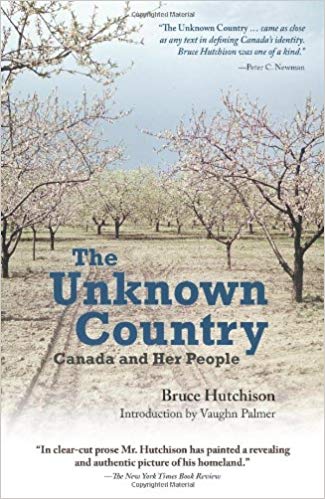The Unknown Country by Bruce Hutchinson (Book Review)

While waiting for a lay-over flight in Reykjavik I struck up a conversation with two Germans (we were all on our way to Frankfurt). We had a pleasant talk and inevitably I told them about where I’m from (Canada), where I grew up (Vancouver), and where I live now (Toronto). An interesting thought experiment arises: if they have met my genetic twin who happened to have grown up and worked in different a Canadian province or city, would they have come away with the same sense of the country being described? What might have been the difference in descriptive flavour if they were talking to a Canadian who was actually born in a different country but now lives here (this being around 22% of the population overall but as high as 51% in Toronto)? And of course if they were from Quebec, then it is impossible the country being described could have been anything like the portrait I was painting.
Canada has always suffered from an identity crisis. In 1867 Canada’s Confederation brought together two Maritime provinces, Upper Canada (what is now Ontario), and Lower Canada (what is now Quebec). Was Canada’s governmental system to be effectively British? If so, how did this square with the roughly 30% of the population that was French speaking and guaranteed their own legal tradition (civil law) and language rights by the Crown after it was conquered? Of course Canada would have its constitution and head of State in the Britain as did the other white settler colonies. But could Canada be both a British political system and hope to win over what are now the Western provinces especially with an aggressive American territorial policy embedded in its view of Manifest Destiny? And what, if anything, was the influence of the aboriginal groups of Canada to be on our political system?
As Canada grew and became the most important country of the Dominions (in terms of population and economic strength) was she to have her own foreign policy? Did a declaration of war by Britain automatically mean one from Canada? During the First World War, who was to be in charge of the Canadian forces? The British were clearly going to have to lead the overall strategic planning given their military size if only as a matter of logistics (just as the British themselves would accept General Eisenhower as the supreme allied commander in World War Two). But what if the Canadian Prime Minister or senior military officers thought that British strategy was inept? Could they refuse orders?
By the time of the Second World War, Canada’s key focus in international relations (outside of promoting its own domestic interests) was keeping the Americans and British on good terms. By 1939 the average Canadian tended to look and speak like her American cousin; often consuming the same media and following contemporary events. But at the elite levels of society (including the law, academia, the bureaucracy, and the political establishment) the Anglo-Saxon tradition dominated (where is wasn’t French of course). Men like Sir John A MacDonald, Robert Bordon, and Lester Pearson were all thoroughly British in their cultural traditions. However, the obvious economic logic of American trade meant that every year Canada was becoming less dependent on the mother country and more dependent on America. It was only through a combination of high tariffs and preferential trading regimes that Britain established that the natural economic tendencies of North American trade were staunched.
A rift between the US and the UK would have literally forced Canada into a crisis either constitutionally or economically. It is unclear which way the country would have gone. On the one hand, Canada immediately joined with Britain and declared war on Hitler’s Germany after the invasion of Poland, and became intimately involved in the war effort mainly through troops and material (Canada was basically able to guarantee Britain’s necessary food imports – as the island would starve otherwise). However Canada also signed a treaty with the Roosevelt government that Canada and the US would jointly defend North America at the Ogdensburg Agreement. Indeed Canada was instrumental in getting the Roosevelt administration to start providing support to the British by having an unofficial understanding that the Royal Navy would be able to station in Canada were mainland Britain to fall to the Nazis. This consideration actually shows up at the end of Churchill’s famous We Shall Fight on the Beaches from June 4, 1940.
[A]nd even if, which I do not for a moment believe, this island or a large part of it were subjugated and starving, then our Empire beyond the seas, armed and guarded by the British Fleet, would carry on the struggle, until, in God’s good time, the new world, with all its power and might, steps forth to the rescue and the liberation of the old.
However after the heroic and successful defence of Britain by the Royal Air Force in the summer months of 1940 and Hitler’s declaration of war on the United States after the attack on Pearl Harbour (it should be noted that it was not clear if the US would actually declare war on Germany, despite it being Japan’s ally) Canada’s worst fears never came to pass. In 1942 an American publisher asked that the well-known Canadian journalist Bruce Hutchinson write a book that would help the average American to better understand her neighbour to the north. The result was Hutchinson’s first book: The Unknown Country: Canada and Her People. Despite the publisher’s reason for the book, the author states in the first pages of the book that if there was an explicit reason for its creation, he no longer remembers what it was. Each chapter of the book provides a small vignette of Hutchinson’s encounters or descriptions of Canada from coast-to-coast. Sometimes it is clear that the events Hutchinson describes are relatively recent (such as when a Quebec farmer denouncing Hitler’s destruction wrought on Europe), other times it is less clear. Hutchinson was born in Ontario, but educated in Victoria, and was probably one of the better travelled individuals of our country at the time. The copy of the book I have is a reprint from 1947, with a beautiful typeface and some charming pictures in the middle of the book.
Hutchinson refers to Canada as the Unknown Country not just to refer to our southern neighbour’s relative obliviousness to us, but also as a reflection of our own internal disorder. True, he says, Canada is a young country, and suffers from an identity crisis as all young people do. But what she lacks in internal understanding she makes up with energy. The book tours through the most important parts of Canada. Even in the 1940s the Atlantic provinces were suffering from depopulation and limited economic opportunities. But there is a sense of community and appeal to history that keeps these communities together. Montreal and Quebec are painted as our most cosmopolitan and refined cities, often compared to both New York and the Old World. It should be remembered Montreal was Canada’s largest city until the 1950s, and only lost its relative economic status to Toronto due to to election of souverainiste provincial governments in the 1970s.
Based on Hutchinson’s description the Torontonians of the 1940s were happy to live in their insular world and be oblivious to most events outside Southern Ontario and all events exceeding 200km from City Hall (it’s nice to know that even 80 years ago some things remain unchanged). Despite this parochialism, by the 1920s Toronto was becoming one of the most important centres of learning in Canada (it was here that Banting discovered insulin and historians like George McKinnon Wrong were pioneering the study of Canadian history). Even before the language politics of 1960-70s Quebec, Toronto was the centre of the law in English speaking Canada and becoming increasingly important for business and finance, especially with its growing connections to the American market.
The Prairie Provinces were arguably the hardest hit by the depression in the 1930s. Farmers were devastated by the collapse of global commodity prices and increased tariffs. Hutchinson highlights that Canadian farmers have always been on the losing side of Canada’s high-tariff regime. Farm equipment must be bought for prices which are a multiple of what they are south of the border in order to “support” manufactured goods in Ontario and Quebec. In return, these producers in Central Canada end up having to “bail out” the rest of the country. This situation is obviously non-optimal. Hutchinson correctly points out that farmers would rather get cheaper inputs and expand their access to world markets then have some subsidies given to them. It is ironic that in contemporary politics it is agricultural interests in Canada which have been the most successful in undermining free trade agreements whereas these same groups have been the most negatively affected historically. Throughout the book Hutchinson makes his views clear that is a “liberal” economic thinker in his support of free trade and general hostility towards socialism.
In one of the last chapters Hutchinson brings his readers to the Land of the Lotus Eaters: also known as Victoria. Of all the Canadian cities, here is the one where a person could lose themselves to the idyll of the temperate climate, rhododendrons, pacific ocean, and comfortable routine of life the locals have established for themselves (playing golf and writing letters to the Victoria Daily Times). Victoria is also arguably the most WASPy city in Canada, both in 1942 and still today! In Hutchinson’s time, the values of the Empire Loyalists still burned strong in the city who bears the name of Regina. While Hutchinson is clearly and openly biased in her descriptions of Canada, the book is still a fascinating snapshot into the structure of Canadian society as this country was in one of its most formative periods.
